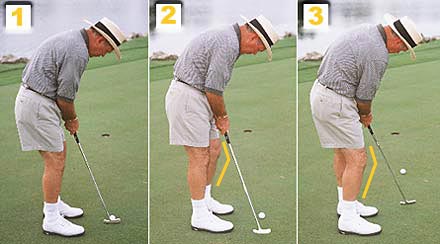Ein legendärer Artikel erschien im März 2001 im GolfDigest Magazine geschrieben von Butch Harmon und Ed Weathers.
Wir möchten diesen Artikel archivieren und Dir bereitstellen, falls Du ihn einmal brauchen solltest.
I can fix your yips :
‚Knee putting‘ breaks the rules, but it’s foolproof‘.
Golf Digest , March, 2001 by Butch Harmon, Ed Weathers
I first saw „knee putting“ back when I was on tour in the late ’60s and early ’70s. Jim Colbert introduced me to it. For people that have the yips–who have a nervous twitch and so have a hard time starting the club back and controlling the blade of the putter throughout the stroke–it’s a foolproof putting method. Why? Because it takes the hands completely out of the stroke.
Knee putting goes against the traditional „rules“ of putting. We’ve been taught to stay completely still, not to move anything but the shoulders when we putt. But with knee putting, almost everything is in motion–your knees, your shoulders, your arms, even your head a little bit. But not your hands. They’re locked in perfectly. And that means even if you’ve got the yips, you can make a ton of putts.
The basics of knee putting:1. Lock the elbows. Foto: Stephen Szurlej
2. Left knee rocks.
3. Right knee rocks.
Lock your elbows, rock your knees
Basically, there are two parts to knee putting:
First, totally lock your elbows against your sides.
Second, just rock your knees. On the backswing, your left knee kicks out and back a little. On the throughswing, the right knee goes out and forward a little. Don’t move your hands at all. Don’t worry about your head moving some–it will. So will your hips and shoulders. No problem, as long as your elbows stay locked in and you don’t use your hands.
Try it first without a club. Just put your hands together in front of you and make the knee-rocking motion. Watch how your hands move. It’s a perfect pendulum movement–just what you want when you putt.
Let ‚rocking‘ speed control distance
On longer putts, knee putting can be a little tricky at first, because you have to get used to the new motion. The key is to let the speed of your knee motion dictate the length of the putt. After you do it for a while, you’ll putt long putts just fine.
But it’s on short putts that people with the yips have the most problems, and for short putts, knee putting is fantastic. Just lock the elbows and rock the knees, and–well, from 10 feet in, to me it’s so good it’s like stealing. (Editor’s note: When Butch Harmon first showed us this cure for the yips, it looked so ugly, we laughed. Then he proceeded to make two out of three 20-footers, lipping out the third. Asked why he doesn’t use the method himself, he replied, „I don’t need it. I already putt great.“)
The Mayo Clinic study: Jack the yipper
OK, you’re standing over a three-footer. Doesn’t matter whether you’re trying to save par to win your club championship or just looking to finish off a 98 in front of your wife and kids before the sun sets. Suddenly your brain starts racing, your heart starts thumping and you’re squeezing the glue out of your putter. Snatch! Jab! Miss. Welcome to the world of the yips. Now it’s also the world of modern medicine.
In the December 2000 issue of the journal Sports Medicine, researchers from the Mayo Clinic, of all places, have published a major study of the yips. It tells us, among other things, that between 32.5 percent and 47.7 percent of better golfers have the problem, that the „most troublesome“ putts for yippers are (in order) three, four and two feet and that, according to a prior study, the yips cost the average yipper 4.7 strokes per round. Yippers also have increased muscle activity, heart rate and grip pressure when they putt, compared to good putters, who actually have decreased muscle activity and heart rate. Oh yeah, and fast, downhill left-to-right putts are most likely to make a yipper’s knees knock.
If you have the yips, there’s only one response to all this: So tell me something I didn’t know–like how to get rid of them.
Sadly, the Mayo Clinic study, whose principal author is Dr. Aynsley M. Smith, offers no neat solutions. In fact, the study says that it’s still not clear what causes the yips: Are they a physical problem aggravated by anxiety, or an anxiety problem that results in a stabby stroke? In the end, the researchers say, „We believe the yips represents a continuum on which ‚choking‘ (anxiety-related) and dystonia symptoms anchor the extremes.“ Translation: Some yippers miss little putts because they choke, some miss because they’ve got a physical disorder, and a lot miss because of some combination of both. (Interestingly, the study indicates that yippers differ little from non-yippers in their consumption of soda, coffee, cigarettes, or alcohol, or in their years of tournament play or frequency of play.)
Why is the Mayo Clinic interested in the yips? „Golf is good exercise and should be a stress-reliever, but the yips just cause more frustration. We want to help people keep playing,“ says Dr. Smith, an occasional golfer (yip-free) whose fellow researchers on the study are mostly low-handicappers. „Besides, the neuroscience, biomechanics and psychology of the yips are all medically fascinating.“ The Mayo Clinic researchers hope to further test yippers at a putting tournament in August at the World Golf Village in St. Augustine, Fla. This will include a test of beta-blockers–drugs said to help some golfers. (For more information, visit www.mayo.edu/research/yips.) Future studies may include tests of grip changes and other possible cures.

